Gamification Statistics: USA 2025
As workplace learning evolves, traditional training methods are falling short of keeping learners engaged and driving measurable outcomes. Enter gamification: a play-based digital learning approach that blends the motivational pull of gameplay with serious learning objectives.
To find out what 434,205 learning leaders in the US's opinions were about gamification, we utilized AI-driven audience profiling to synthesize insights from online discussions over a year ending 7 July, 2025, to a high statistical confidence level. These data-driven results reveal how these immersive experiences are being used to do more than just educate, and why learning leaders are integrating them in their organizations.
Index
- 42% of learning leaders are primarily motivated to use gamification in training to encourage repeat participation and boost learner engagement
- 47% of learning leaders agree that interactive storytelling is absolutely essential to effective gamified learning
- 21% of learning leaders say that gamification is a highly effective format for compliance training
- 23% of business leaders say that gamification has a transformative impact on getting better training feedback
- 14% of learning leaders lean towards a playful and lighthearted tone for gamified learning content
- Social learning platforms are extremely effective for gamified training for 44% of learning leaders
- 20% of learning leaders absolutely ensure they focus on learner feedback to keep their gamified programs inclusive
- Low learner buy-in is a significant challenge for 43% of learning leaders trying to implement gamification
- Social reinforcement majorly influences 36% of learning leaders’ approach to gamification
- 21% of learning leaders say that gamification should reinforce core training goals
- 46% of learning leaders say that people and culture gain a significant advantage from gamified learning tools
- 61% of learning leaders agree that gamification is extremely effective for driving learner engagement in community challenges
- 15% of learning leaders in the US are absolutely based in the Southwest
- Gamification’s growing role in culture-driven learning strategy
- Methodology
What Motivates You Most To Use Gamified Elements In Training?
42% of learning leaders are primarily motivated to use gamification in training to encourage repeat participation and boost learner engagement
Motivations for incorporating gamified elements into training vary:
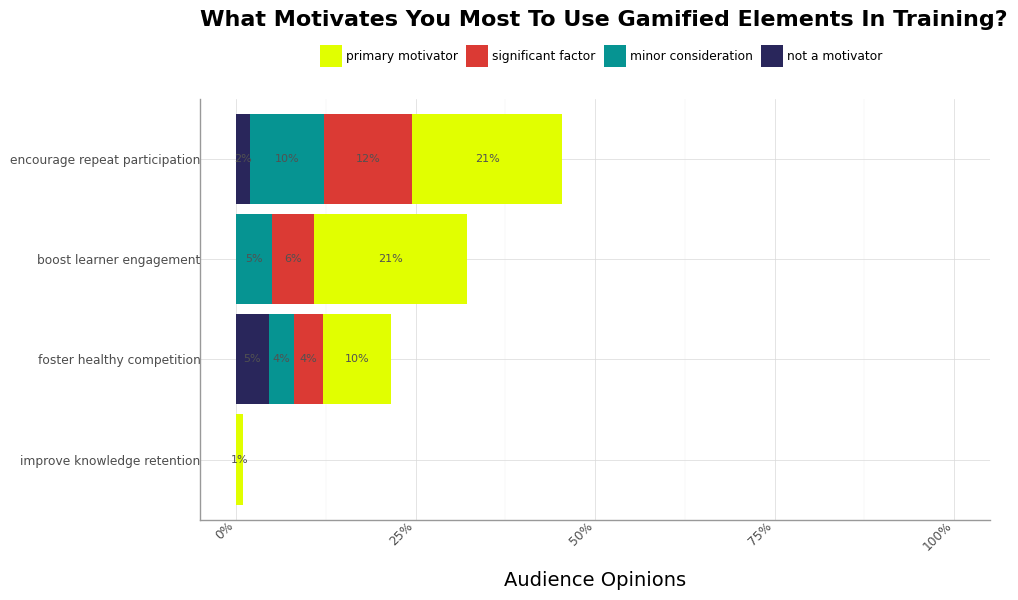
Incorporating gamification in training has numerous benefits, and these benefits serve as major motivators for learning leaders who want to deliver more dynamic, results-driven experiences.
For our audience, encouraging repeat participation and boosting learner engagement are the primary motivators for 42%, split evenly into 21% each. 12% and 6% respectively also say these two motivations are a significant factor in using gamification for training, and 10% and 5% agree it’s a minor consideration. In contrast, just 2% say it’s not a motivator for encouraging repeat participation.
Considering studies show that using gamification can increase engagement and lead to an 82% increase in performance, it’s understandable why so many leaders consider this a major motivator. Additionally, the more engaged learners are, the more likely they are to want to participate in future training, so there’s a knock-on effect.
Fostering healthy competition was also a good motivator for incorporating gamified elements in training, with 10% of our audience saying it was a major motivator, 4% a significant factor, and 4% a minor consideration. However, 5% said it wasn’t a motivator, likely due to their learning model.
Just 1% said that their primary motivator was to improve knowledge retention, proving that while retention is important, most learning leaders are prioritizing immediate engagement and participation over long-term outcomes, or perhaps viewing retention as a natural byproduct of higher engagement rather than a standalone goal.
Which Element Do You Believe Is Most Essential To Effective Gamified Learning?
47% of learning leaders agree that interactive storytelling is absolutely essential to effective gamified learning
One element stands out as the most crucial for effective gamified learning:
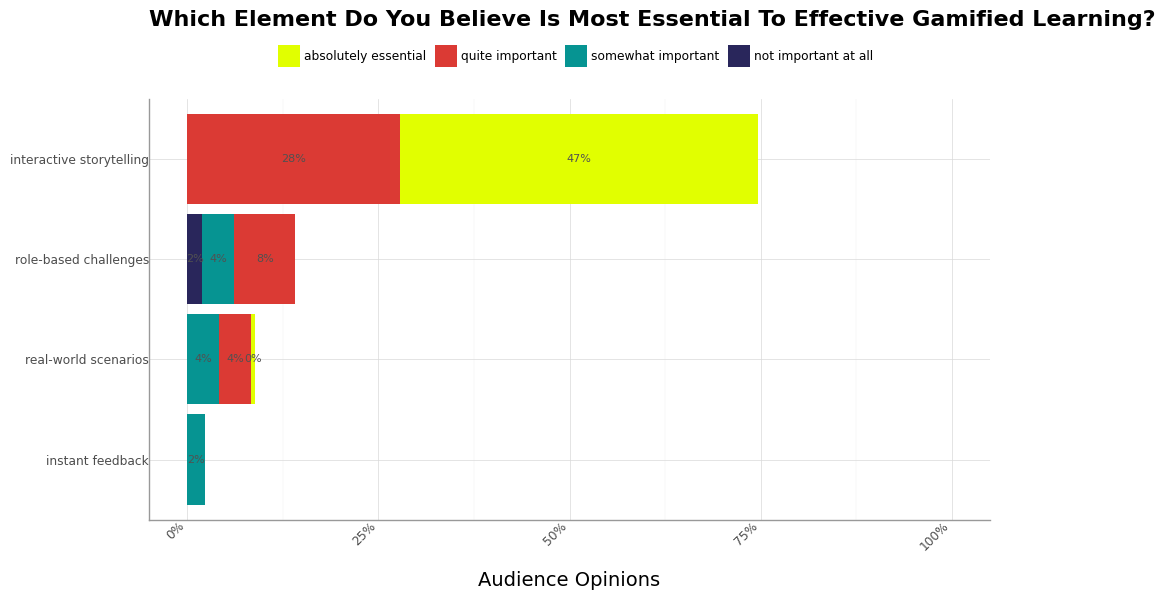
Interactive storytelling is considered the element most essential to effective gamified learning, with 47% of learning leaders saying it’s absolutely essential and 28% saying it’s quite important. This aligns with research showing that within gamified environments, interactive storytelling significantly enhances immersion in learning systems.
Role-based challenges take second place, with 8% of our audience saying they’re quite important to gamified learning and 4% saying they are somewhat so. However, 2% say they’re not important at all.
Real-world scenarios are considered quite important and somewhat important gamification elements for 8%, while instant feedback is somewhat important for 2%. Overall, the major focus on interactive storytelling suggests that learning leaders are increasingly valuing emotionally engaging, narrative-driven experiences that place learners at the center of the action above all else.
Which Learning Format Benefits Most From Gamification?
21% of learning leaders say that gamification is a highly effective format for compliance training
Opinions differ on where gamification is most effective:
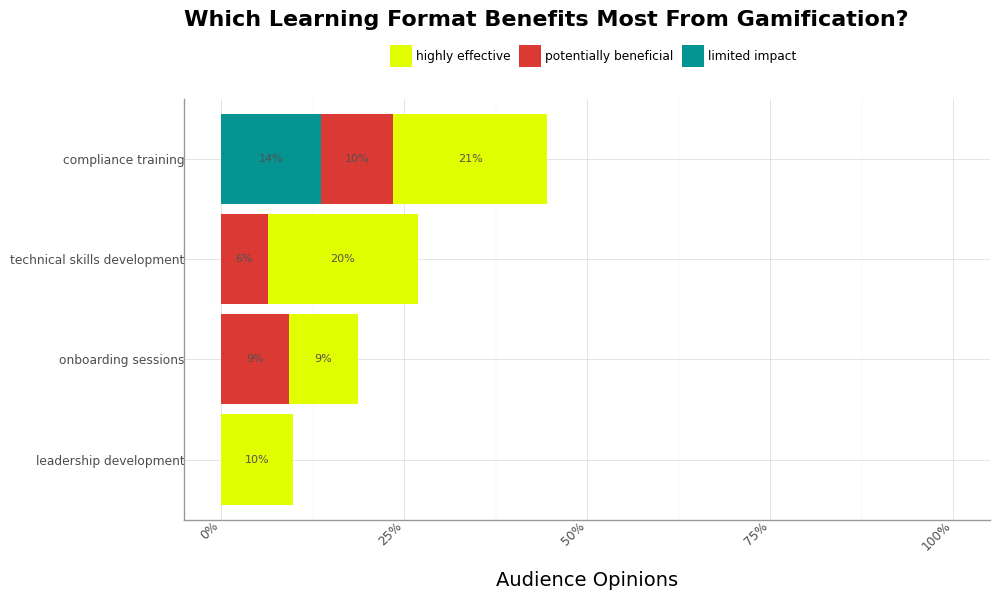
It’s estimated that between 2024 and 2029, the corporate compliance training market size will increase by $5.6 billion at a CAGR of 11.6%. With the market being so big, it’s unsurprising that the largest number of learning leaders in our audience agree that this is the learning format where gamification offers the most benefit. 21% say it’s highly effective in compliance training, 10% that it’s potentially beneficial, and 14% that it has limited impact.
Next up is technical skills development, with 20% saying it's highly effective and 6% that it’s potentially beneficial, followed by onboarding sessions, with 5% each saying it's highly effective and potentially beneficial. A solid 10% also say that using gamification in leadership development is highly effective, showcasing the diverse ways this process can be applied successfully.
What Outcome Do You Most Associate With Successful Gamification?
23% of business leaders say that gamification has a transformative impact on getting better training feedback
Gamification success is measured in different outcomes, with clear trends:
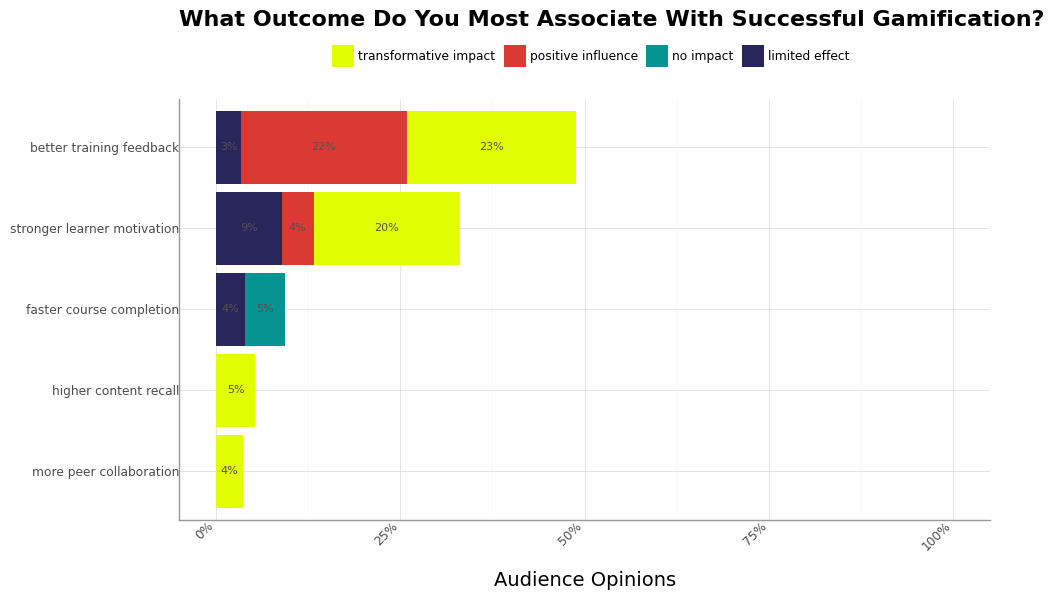
For our audience of learning leaders, it’s evident that better training feedback is the outcome most associated with successful gamification. 23% say it has a transformative impact and 22% a positive influence, while only 3% say it has a limited effect. This aligns with findings reported by the Harvard Business Review, which noted that gamified training that’s designed with progression, levels, feedback, points, and competition can significantly improve performance.
Stronger learning motivation was a close second, with 20% of the audience saying it has a transformative impact, but only 4% agreed it had a positive influence, and 9% said it had a limited effect. Other outcomes that were most associated with successful gamification were higher content recall (5%) and more peer collaboration (4%), both of which learning leaders saw a transformative impact in. All of these outcomes reinforce the growing consensus that well-executed gamification enhances engagement and actively supports deeper learning, stronger knowledge retention, and a more collaborative training environment.
What Tone Or Feel Do You Prefer In Gamified Learning Content?
14% of learning leaders lean towards a playful and lighthearted tone for gamified learning content
There’s a close split in audience opinions on the preferred delivery style of gamified content:
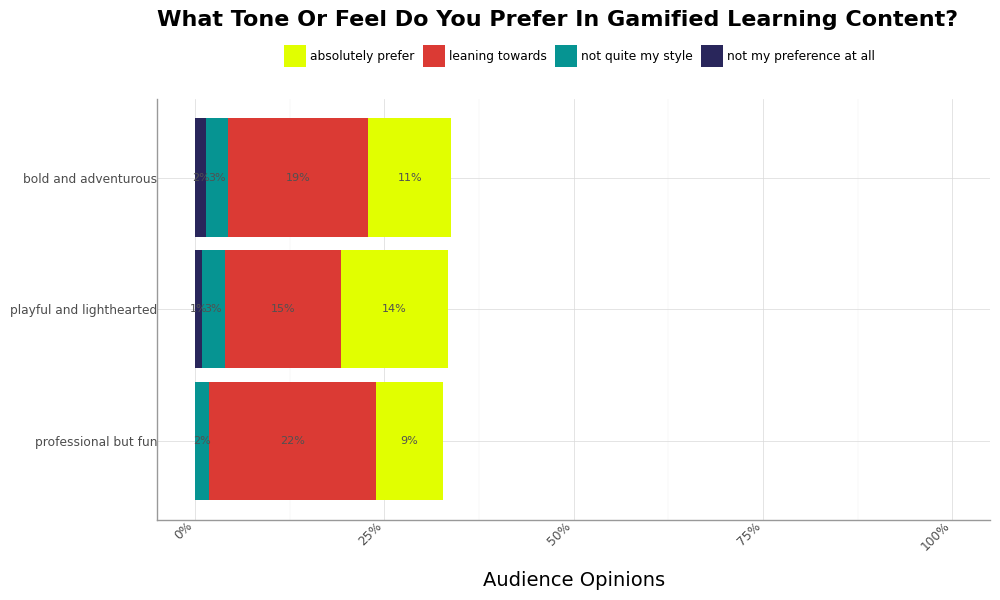
It’s abundantly clear there are three types of tone and feel that our audience prefers in gamified content, and similar opinions were recorded for each.
Playful and lighthearted content was the tone 14% of learning leaders absolutely preferred, followed by 11% who felt the same about bold and adventurous content, and 9% who shared the same sentiments regarding content that was professional but fun.
While in first place with those who absolutely preferred it, playful and lighthearted content only had 15% of those who said they leaned towards this feel and tone, while a bold and adventurous tone had 19% and professional but fun 22%.
Interestingly, bold and adventurous and playful and lighthearted was the tone 3% said was not their style, while 2% felt the same about professional but fun content. 2% and 1% also said that bold and adventurous and playful and lighthearted content was not their preference at all, showing that although opinions were similar across the board, there were some small but important differences.
What Platform Do You Find Most Effective For Gamified Training?
Social learning platforms are extremely effective for gamified training for 44% of learning leaders
Gamified training works better across some platforms than others:
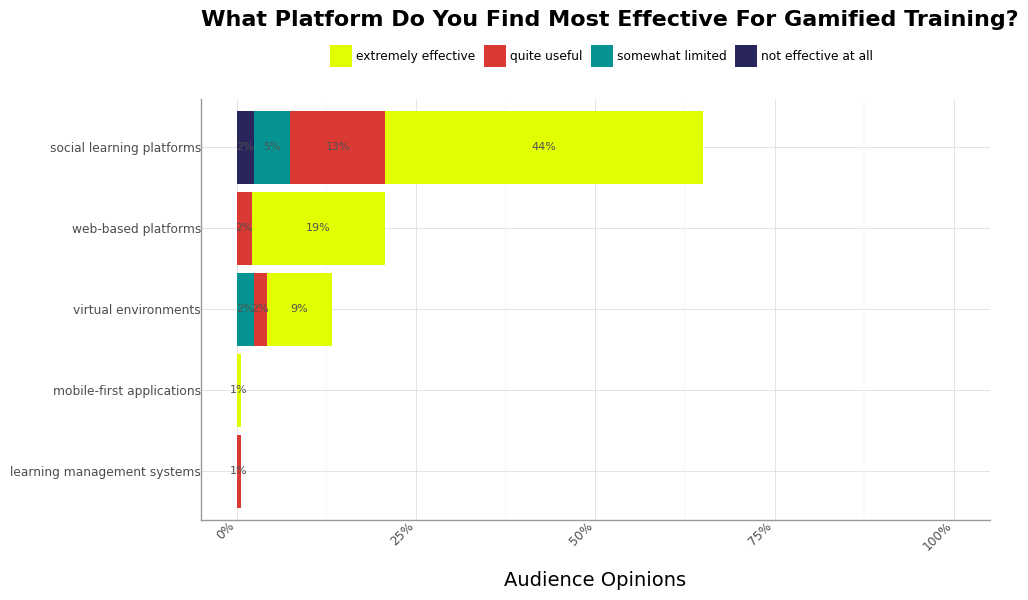
In the early 2000s, companies began using learning management systems (LMS) to train employees and advance their operations, and with the rise of Facebook and other social media platforms, a new digital version of social learning took flight. It’s understandable then that social learning platforms are the platform that the most (44%) learning leaders find the most effective for gamified training, while 13% find it quite useful. Conversely, only 5% say it's somewhat limited, and just 2% say it's not effective at all.
19% of learning leaders find web-based platforms extremely effective and 2% quite useful, followed by 9% and 2% who share the same opinions about virtual environments. However, another 2% say that they find virtual environments somewhat limited in gamified training.
Mobile first applications are extremely effective for 1% and LMS quite useful for the final 1%, highlighting that while social learning platforms dominate in terms of perceived effectiveness for gamified training, other technologies like web-based platforms and virtual environments still hold niche but valuable roles in certain learning strategies.
How Do You Ensure Your Gamified Programs Remain Inclusive?
20% of learning leaders absolutely ensure they focus on learner feedback to keep their gamified programs inclusive
Inclusivity is essential in training and learning leaders adopt different approaches to it:
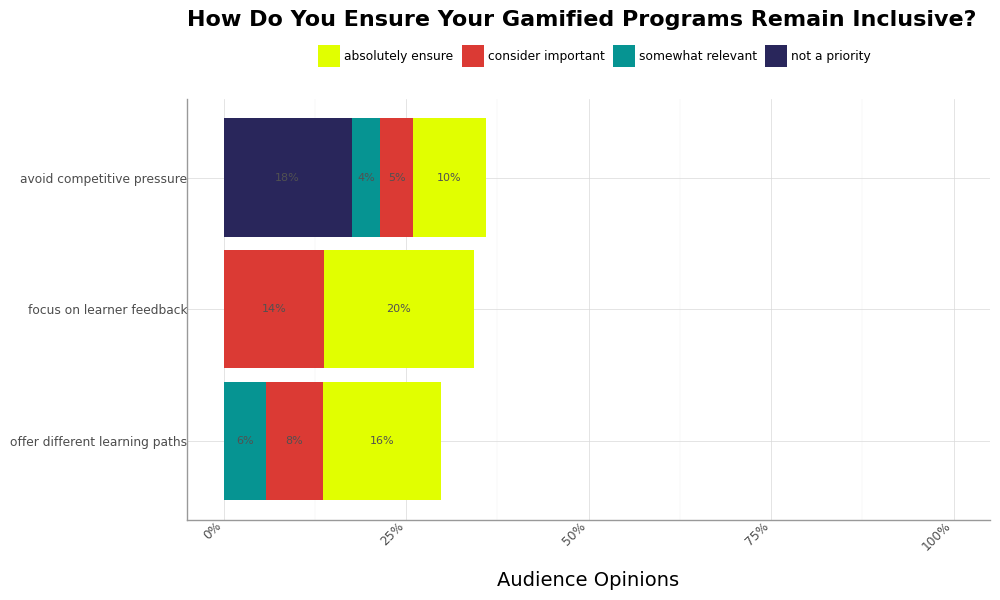
McKinsey’s Diversity Matters Even More report shows that organizations prioritizing belonging and inclusive practices have better-performing employees. This reinforces why having inclusive gamified training programs is so important, and for our audience, there are three ways this is done.
20% of learning leaders ensure their programs are inclusive by absolutely ensuring they focus on learner feedback to make adaptations and updates, while another 14% consider this focus important in maintaining inclusion.
16% absolutely ensure they offer different learning paths to accommodate everyone, 8% consider doing so important, and 6% say this is somewhat relevant. Another 10% absolutely ensure their programs remain inclusive by avoiding competitive pressure, while 5% say they consider this important, and 4% somewhat relevant. However, 18% say this is not a priority for them, likely because their program or working environment is not driven by competition or they don’t view competitive pressure as a barrier to inclusion.
What Challenge Do You Face Most When Implementing Gamification?
Low learner buy-in is a significant challenge for 43% of learning leaders trying to implement gamification
One challenge stands out for learning leaders implementing gamification programs:
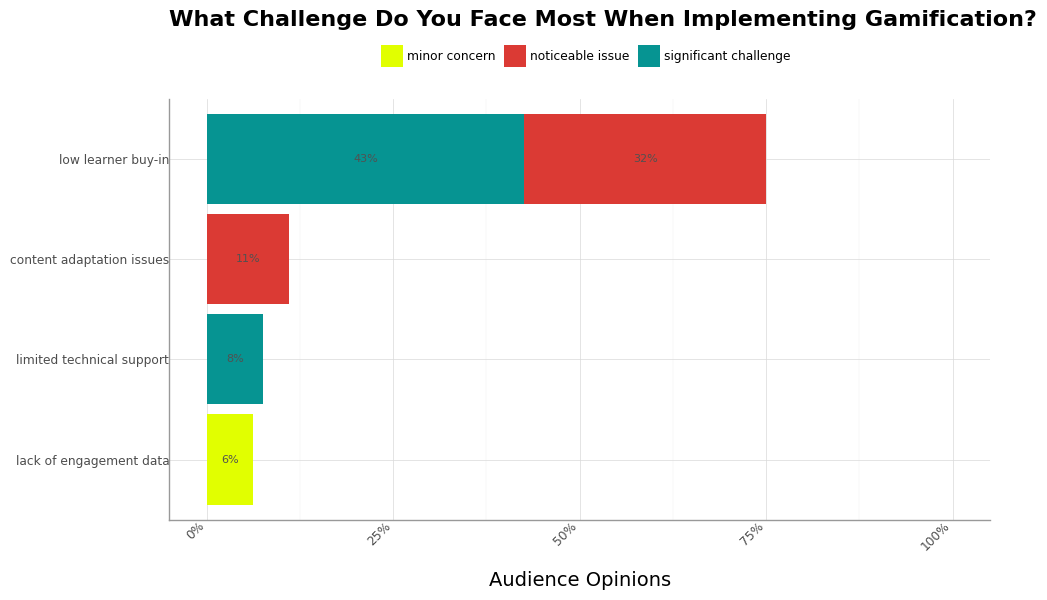
With a combined 75% of our audience saying that low learner buy-in is their biggest challenge when implementing gamification, it’s obvious that the majority of learners still need to discover just how engaging and impactful this type of learning can be. Of the 75%, 43% say buy-in is a significant challenge, and 32% agree it’s a noticeable issue.
In comparison, those who say limited technical support is a significant challenge number only 8%, 11% say content adaptation issues are a noticeable issue, and 6% say a lack of engagement data is a minor concern. This suggests that while technical and content-related hurdles exist, they pale in comparison to the human factor.
Which Industry Trend Most Influences Your Approach To Gamification?
Social reinforcement majorly influences 36% of learning leaders’ approach to gamification
Certain trends have a major influence over approaches to gamification:
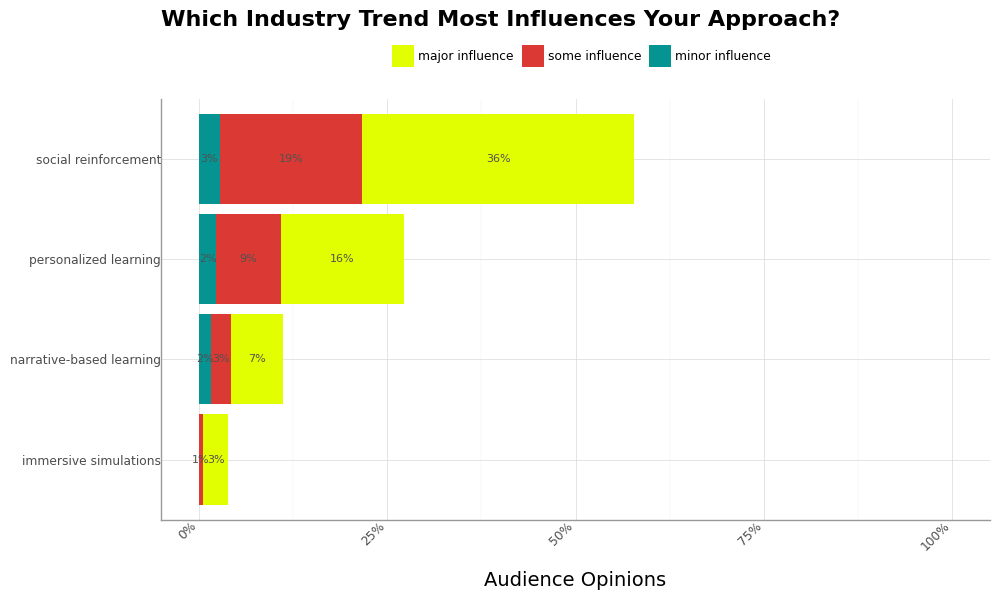
In learning and gamification, social reinforcement can take the form of peer recognition, leaderboards and rankings, team-based challenges with shared rewards, or positive feedback. This taps into learners' inherent desire for social belonging and validation, making it a powerful motivator in training. Understandably, then, social reinforcement is the industry trend that most influences learning leaders' approach to gamification, with 36% saying it’s a major influence, 19% that it has some influence, and 3% agreeing it’s a minor influence.
Personalized learning is another trend that has a reasonable amount of influence, and 16% say it majorly influences their approach, while 9% say it has some influence, and 2% say it has a minor influence.
Narrative-based learning trends have a lesser impact, with 7% saying they majorly influence their approach, 3% somewhat, and another 3% saying their impact is minor. Immersive simulations come in last with 3% saying this trend is a major influence and 1% agreeing that it somewhat influences them, suggesting that while immersive technologies hold potential, they are not yet a primary focus for most learning leaders.
What Role Should Gamification Play In Learning Strategy?
21% of learning leaders say that gamification should reinforce core training goals
Opinions on the role of gamification in learning differ somewhat:
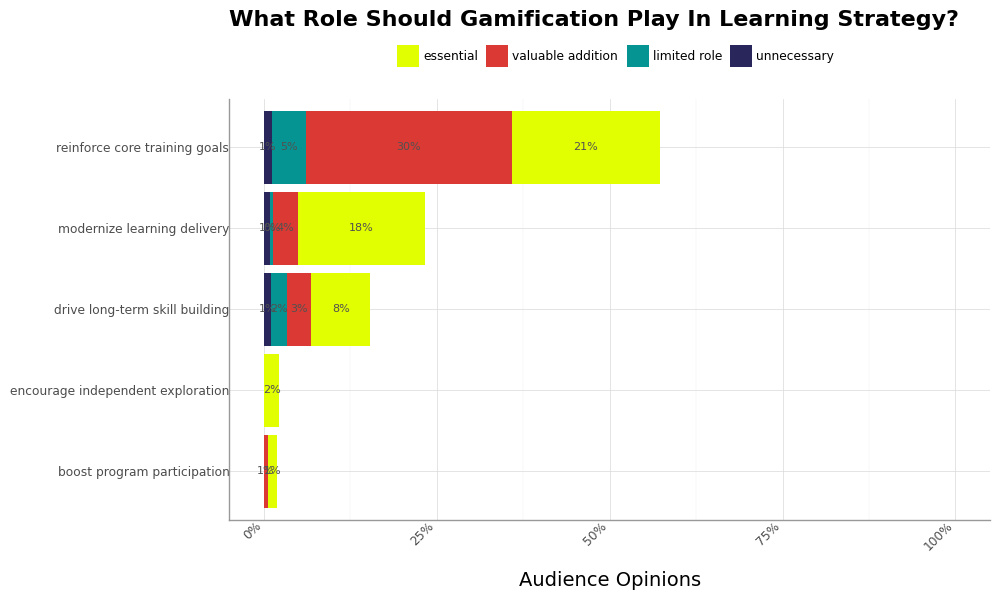
With just over 50% of learning leaders saying that gamification should reinforce core training goals, it’s clear this is the biggest focus when designing or implementing gamified experiences. And for good reason. Studies have repeatedly shown just how effective gamification can be in training and in helping learners to reach their objectives. 21% say gamification plays an essential role, while 30% say it’s a valuable addition. However, 5% say it only plays a limited role in learning strategy, and 1% say it’s unnecessary, so there are some differing opinions.
18% of learning leaders say gamification is essential in modernizing learning delivery, 4% say it’s a valuable addition, and 1% say it’s unnecessary, while 8% feel it’s essential for driving long-term skill-building, and 3% agree it’s a valuable addition in this regard. However, 2% say it plays a limited role and 1% find it unnecessary.
Although the encouragement of independent exploration and boosting program participation garnered few opinions, with the former racking up 2% who said it was essential and another 2% who said it was essential or a valuable addition, it’s clear most learning leaders still prioritize alignment with core training goals over secondary benefits.
Which Team Benefits Most From Gamified Learning Tools?
46% of learning leaders say that people and culture gain a significant advantage from gamified learning tools
There’s a definite consensus on the teams benefiting the most from gamified learning:
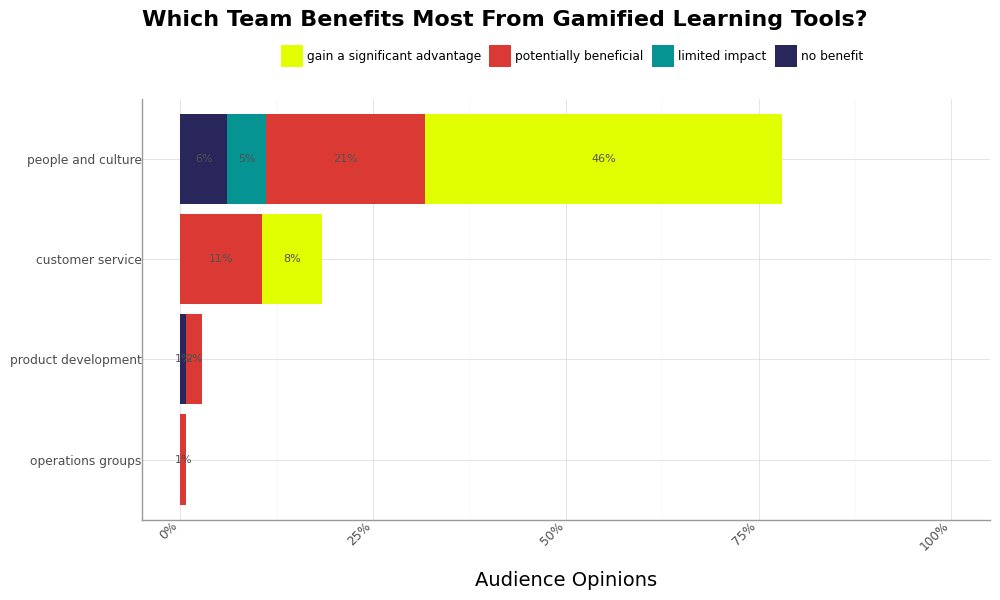
In recent studies, organizational culture has been identified as one of the factors responsible for the success or failure of an organization, and for our audience of learning leaders, this is where introducing gamification has the most benefits. 46% are of the opinion that people and culture gain a significant advantage from gamified learning tools, 21% say the potential benefit, and 5% say they see limited impact. Only 6% say these tools have no benefit here.
Those who say gamified learning tools benefit customer service teams number 8% who say they gain a significant advantage, and 11% who say they’re potentially beneficial. Comparatively, the benefits for product development teams and operations groups are very low, with 2% saying they potentially benefit the former and 1% saying they have no benefit, and 1% saying they’re potentially beneficial for the latter.
These opinions suggest learning leaders primarily see gamification as a tool for shaping internal culture and enhancing employee engagement rather than as a direct driver of operational or product-related outcomes.
What Drives Learner Engagement The Most In Your Experience?
61% of learning leaders agree that gamification is extremely effective for driving learner engagement in community challenges
Gamification is evidently a huge driver in enhancing a specific part of learner engagement:
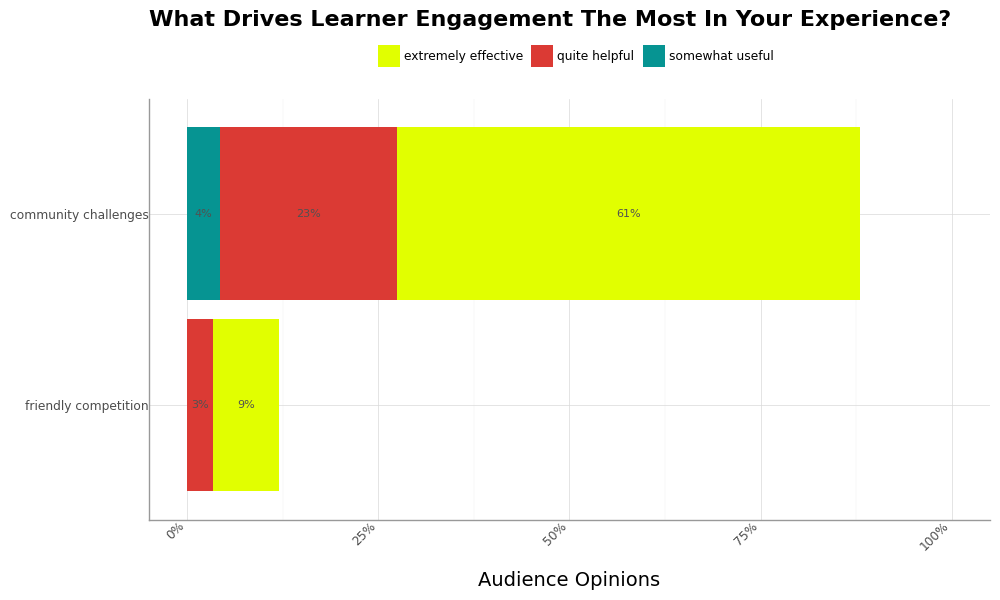
With organizational culture being so integral to success, it's no surprise 61% of learning leaders agree that gamification is extremely effective for driving learner engagement in community challenges, 23% say it’s quite helpful, and 4% agree it’s somewhat useful. This reflects a broader recognition that when learning is socially engaging and culturally aligned, it boosts participation and strengthens the sense of belonging and collaboration across teams.
9% of the audience also say that gamification is extremely effective at driving learner engagement by enhancing friendly competition, and another 3% say it’s quite helpful. This shows that while community challenges remain the most powerful application of gamification, incorporating elements of friendly competition still plays a meaningful role in keeping learners motivated.
Which Region Best Describes Where Your Organization Is Based?
15% of learning leaders in the US are absolutely based in the Southwest
The regional distribution of learning leaders in our audience reveals where most reside:
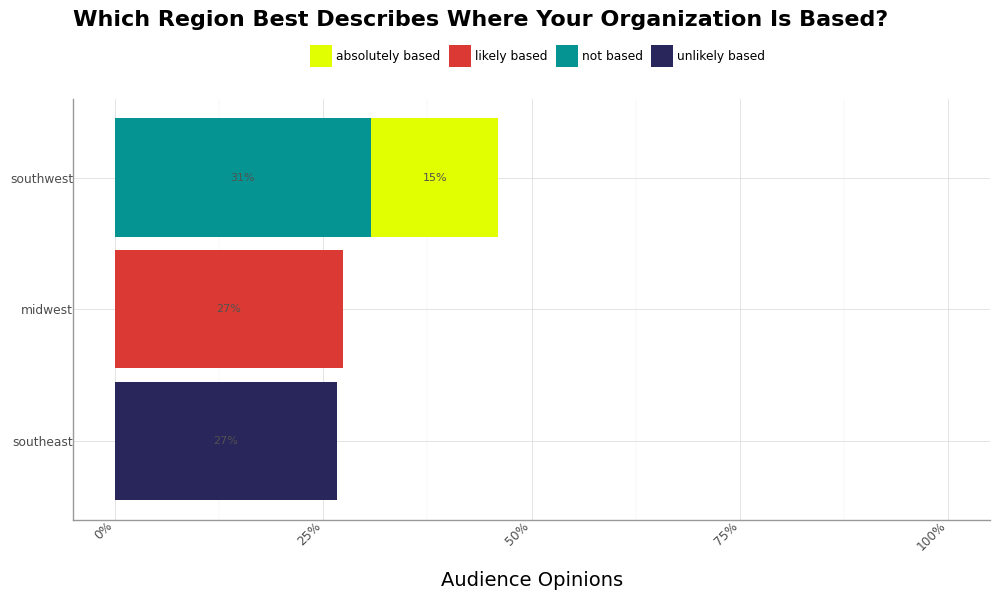
The Southwest region of the US is a significant area for business development, especially in sectors like technology, renewable energy, logistics, and manufacturing. It’s also where 15% of our audience of learning leaders’ organizations are absolutely based. However, 31% say they’re not based here, while 327% say they’re likely based in the Midwest.
It’s also unlikely that 27% are based in the Southeast, putting the focus firmly on the Southwest with the largest percentage.
Gamification’s Growing Role in Culture-Driven Learning Strategy
As this data makes clear, gamification has moved beyond novelty and is now a strategic, culturally relevant tool that helps learning leaders to improve engagement, encourage a sense of community, and align training with business goals.
From boosting compliance training effectiveness to transforming feedback collection, gamified learning is helping organizations shape more inclusive, participatory, and people-driven learning environments. While challenges like learner buy-in still exist, the overall direction is clear. Gamification is becoming central to how learning leaders drive real behavioral and cultural impact within their teams.
Methodology
Sourced using Artios from an independent sample of 434,205 United States learning leaders' opinions across X, Reddit, TikTok, LinkedIn, Threads, and BlueSky. Responses are collected within a 85% confidence interval and 5% margin of error. Results are derived from opinions expressed online, not actual questions answered by people in the sample.
About the representative sample:
- 53% of learning leaders in the US are between the ages of 35 and 64 years old.
- 51% identify as female and 49% as male.
- 59% earn between $200,000 and $500,000 annually.
- 36% are based in the Pacific US.